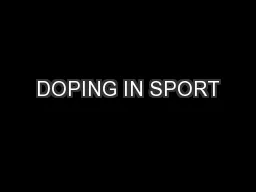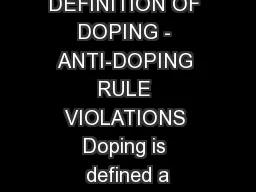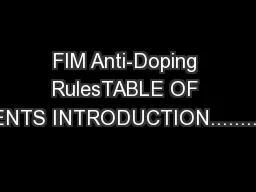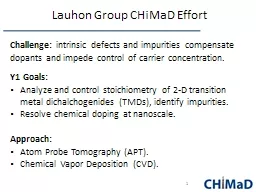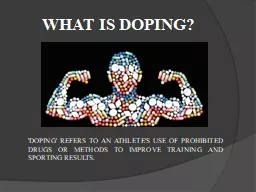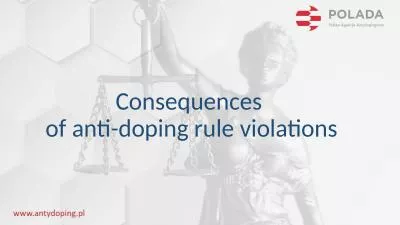PPT-DOPING Benedetta Biondi Eleonora Cardella
Author : lois-ondreau | Published Date : 2018-03-09
Raffaele de Santis Luca Di Vito Lorenzo Sarracco Doping in sport In competitive sports doping refers to the use of banned athletic performanceenhancing drugs
Presentation Embed Code
Download Presentation
Download Presentation The PPT/PDF document "DOPING Benedetta Biondi Eleonora Cardell..." is the property of its rightful owner. Permission is granted to download and print the materials on this website for personal, non-commercial use only, and to display it on your personal computer provided you do not modify the materials and that you retain all copyright notices contained in the materials. By downloading content from our website, you accept the terms of this agreement.
DOPING Benedetta Biondi Eleonora Cardella: Transcript
Raffaele de Santis Luca Di Vito Lorenzo Sarracco Doping in sport In competitive sports doping refers to the use of banned athletic performanceenhancing drugs by athletic competitors where the term . Doping and deviance. Common sense and alternative understandings: testing the arguments. Anti-doping policy and disciplinary . society. and . d. oping . in the sport . media. A short history of football. Created and Presented by Timothy von Behren. DOPING. : . using a substance or method which is potentially harmful to an athlete’s health and/or capable of enhancing performance. The WADA was created in 1999. negligence or knowing Use on the Athlete FIM Anti -Doping Rul e A nti-Dopin F Tournament. Chaperones. Why a Chaperone ?. ( sometimes known as steward, attendant, escort ). To verify that anti-doping regulations have been followed . To improve the quality of the Doping Control process. . Materials Use-Case Group. Mark Hersam, NU. Lincoln Lauhon, NU. Albert Davydov, NIST. Francesca Tavazza, NIST. Arunima Singh, NIST. Vision Statement. : Understand and realize p-type and n-type doping in the low-dimensional limit. . Put in your name. Put in the logo for all slides. Content of the briefing. Facilities. Doping control and testing. Injury treatment and reports. Questions and other matters. Facilities. During matches. By Amanda Solnitzky, Michael Holzmann and Mitchell Vining. What is a performance enhancing drug? (PED). A performance enhancing drug is any substance taken by athletes to improve performance.. This typically refers to anabolic steroid use in sports by athletes but there are many other substances classified as a performance enhancing drug.. Anti-Doping Policies The Athletic Trainer’s Role Are they really CHEATERS? Nadine Waeghe, ATC, PT Objectives Overview of Doping Control Process: Governing Bodies Anti-Doping Organizations Legal Implications MOST USED DRUGS AND MEDICINES . STEROIDS. , STIMULANTS, HORMONES, DIURETICS, . NARCOTICS, MARIJUANA, ANTINFLAMMATORY STEROIDS, ANABOLIC . STEROIDS WHICH ACCELERATE MUSCLES DEVELOPMENT MEDICINES WHICH CONCEAL THE EFFECTS OF STEROIDS THE SO CALLED “ MASKING AGENTS” . 01/12/2017. Roberto Cardella. 1. Roberto Cardella, . CERN . EP-DT-DD. A. . Andreazza, A. . Calandri. , M. Benoit, I. Berdalovic, B. . Blochet. ,. J. . Bronuzzi,. . . R. . . Casanova, V. Dao, . N. Egidos, F. . AN OLYMPIC PERSPECTIVE. Dr. Janice A. Harvey FISU CM. DOPING CONTROL IN A WINTER GAMES AN OLYMPIC PERSPECTIVE. VANOC Anti-Doping Mission. :. Deliver a state-of-the-art doping control program at the 2010 Games to ensure all athletes can compete on a level playing field.. (a) . Disqualification . means the athlete’s results in a particular competition or event are invalidated, with all resulting consequences including forfeiture of any medals, points and prizes; . recent . results and future . perspectives. G.Cardella. . for. the CHIMERA group . Outline. CHIMERA & FARCOS. . Results with stable beams. . Radioactive beams. . New ways to use CHIMERA/FARCOS and on-going upgrades.
Download Document
Here is the link to download the presentation.
"DOPING Benedetta Biondi Eleonora Cardella"The content belongs to its owner. You may download and print it for personal use, without modification, and keep all copyright notices. By downloading, you agree to these terms.
Related Documents


